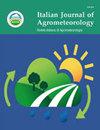苄基腺嘌呤补偿低供水条件下大豆产量下降的效果
IF 0.8
4区 农林科学
Q2 AGRONOMY
Italian Journal of Agrometeorology-Rivista Italiana Di Agrometeorologia
Pub Date : 2021-12-27
DOI:10.36253/ijam-872
引用次数: 27
摘要
毫无疑问,干旱是气候变化的负面后果。农民必须解决这个问题,可能被迫用比所需更少的水灌溉作物,但预计生产力会下降。因此,进行了两年的田间试验,以评估灌溉制度(作物蒸发蒸腾量的60%、80%和100%,分别表示为ET60、ET80和ET100)和苄基腺嘌呤率(0、50、100、150和200 mg L−1,分别象征为BA0、BA50、BA100、BA150和BA200)对大豆的影响。研究结果表明,在两个季节,ET100或ET80×BA200或BA150的相互作用使株高和净同化率增加最大。ET80 x BA200(在两个季节)和ET100 x BA150(在第一个季节)在提高荚数植物−1方面与ET100 x BA 200相似。灌溉用水效率随着灌溉水量的减少和苄基腺嘌呤用量的增加而逐渐提高。总之,150 mg L−1的苄基腺嘌呤可以补偿因供水量减少而导致的种子产量下降,最高可减少作物蒸发蒸腾量的80%(节省灌溉用水的20%),因此应将其纳入大豆灌溉计划。本文章由计算机程序翻译,如有差异,请以英文原文为准。
Efficacy of benzyladenine for compensating the reduction in soybean productivity under low water supply
Undoubtedly, drought is a negative consequence of climate change. Farmers have to deal with this issue and may be forced to irrigate their crops with less water than required, however reduction in productivity is anticipated. Thus, two–year field trials were conducted to assess the impact of irrigation regimes (60, 80 and 100% of crop evapotranspiration, denoted ET60, ET80, and ET100, respectively) and benzyladenine rates (0, 50, 100, 150 and 200 mg L−1, symbolized as BA0, BA50, BA100, BA150, BA200, respectively) on soybean. Findings clarified that the maximum increases in plant height and net assimilation rate were obtained with the interactions of ET100 or ET80 x BA200 or BA150 in both seasons. ET80 x BA200 (in both seasons) and ET100 x BA150 (in the first season) were as similar as ET100 x BA200 for enhancing pods number plant−1. Irrigation water use efficiency progressively increased with decreasing irrigation water amount and increasing benzyladenine rate. In conclusion, the reduction in seed yield due to lowering water supply up to 80% of crop evapotranspiration (with saving 20% of irrigation water) could be compensated using benzyladenine, 150 mg L−1, thus it should be involved in soybean irrigation programs.
求助全文
通过发布文献求助,成功后即可免费获取论文全文。
去求助
来源期刊

Italian Journal of Agrometeorology-Rivista Italiana Di Agrometeorologia
AGRONOMY-ENVIRONMENTAL SCIENCES
CiteScore
2.10
自引率
8.30%
发文量
6
期刊介绍:
Among the areas of specific interest of the journal there are: ecophysiology; phenology; plant growth, quality and quantity of production; plant pathology; entomology; welfare conditions of livestocks; soil physics and hydrology; micrometeorology; modeling, simulation and forecasting; remote sensing; territorial planning; geographical information systems and spatialization techniques; instrumentation to measure physical and biological quantities; data validation techniques, agroclimatology; agriculture scientific dissemination; support services for farmers.
 求助内容:
求助内容: 应助结果提醒方式:
应助结果提醒方式:


